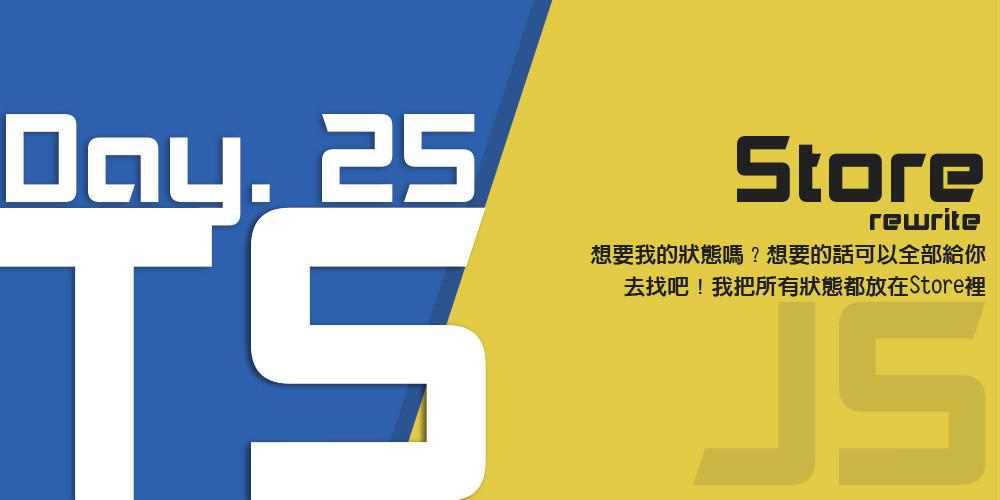
想要我的狀態嗎? 想要的話可以全部給你,
去找吧!我把所有狀態都放在Store裡。
───────────────────────── By 哥爾‧D‧羅傑
// index.js
import { createStore } from "vuex";
import user from "./user"; // 登入、使用者相關
import route from "./route"; // 路由相關
export default createStore({
state: {},
getter: {},
actions: {}, // 變動state 用(可非同步)
mutations: {} // 變動 state 用(只能同步)
modules: { user, route },
});
看的出來有兩個
modules,
我們一個一個來處理:
這段式原先的JS
我們複製一個,丟進'src/store/'裡,
並把檔名改成user.ts
會發現很多地方開始提醒你有問題:
// user.ts
import { Base64 } from "js-base64";
export const state = {
isLogin: false, // 是否有登入
jwtToken: '',
userData: {
// 登入資訊
user: '',
name: '',
/** 使用者權限劃分 permission level
* 0 最高管理者 全開
* 1 網站管理者
* 2 一般使用者
* 3 訪客
*/
auth: '3',
},
};
export const actions = {};// 非同步
export const mutations = { // 同步
signIn(state) { state.isLogin = true; },
signOut(state) { state.isLogin = false; },
/** 將登入後的 Token 轉 成userData
* @param {*} state
* @param {JWT} JWT
*/
setUser(state, JWT) {
state.jwtToken = JWT;
// JWT = header.payload.Signature
const Token = JWT.split("."); // 解析使用者資料
const data = JSON.parse(Base64.decode(Token[1]));
// 記錄登入者資訊
state.userData.user = data.user;
state.userData.name = data.name;
state.userData.auth = data.auth;
},
};
export const getters = {
isAuthenticated: state => !!state.user || !!sessionStorage.getItem("user"),
};
export default {
state,
getters,
actions,
mutations,
namespaced: true,
};
看來看去,最主要的問題是,
state的型別沒有宣告,所以我們改成這樣:
// user.ts
// 把使用者權限列舉起來
enum PERMISSION_LEVEL {
TOP_MANAGEMENT, // 0 最高管理者 全開
MANAGER, // 1 網站管理者
USER, // 2 一般使用者
VISITOR // 3 訪客
}
// 宣告、並匯出user的State
export interface iUserState {
isLogin: Boolean, // 是否有登入
jwtToken: string,
userData: {
user: string,
name: string,
auth: PERMISSION_LEVEL,
},
}
export default {
namespaced: true,
state: {
isLogin: false,
jwtToken: '',
userData: {
user: '',
name: '',
auth: PERMISSION_LEVEL.VISITOR,
},
},
// 把state通通補上型別
mutations: { // 同步
signIn(state: iUserState) { state.isLogin = true; },
signOut(state: iUserState) { state.isLogin = false; },
/** 將登入後的 Token 轉 成userData
* @param {*} state
* @param {JWT} JWT
*/
setUser(state: iUserState, JWT: string) {
state.jwtToken = JWT;
// JWT = header.payload.Signature
const Token = JWT.split("."); // 解析使用者資料
const data = JSON.parse(Base64.decode(Token[1]));
// 記錄登入者資訊
state.userData.user = data.user;
state.userData.name = data.name;
state.userData.auth = data.auth;
},
},
getters: { // 這邊順便被提醒state.user 不存在,把userData補上去。
isAuthenticated: (state: iUserState) => !!state.userData.user || !!sessionStorage.getItem("user"),
}
}
然後安裝一下:
js-base64
JWT機制,解碼用的:
yarn add js-base64 -D
由於
js-base64已經自帶.d.ts了,
所以你啥都不用做就可以直接用了。
剛改寫第一支JS程式,馬上就體驗到TS的好用與方便。route.js的改寫方式大同小異,這邊就省略掉了。
modules都改寫完之後,把昨天調整過的
src/store/index.js改成這樣:
import { InjectionKey } from 'vue'
import { createStore, useStore as baseUseStore, Store } from 'vuex'
import { iRouteState } from './modules/route'; // 路由相關
import { iUserState } from './modules/user'; // 登入、使用者相關
export interface State {
route: iRouteState,
user: iUserState,
}
// 全部模組導入
let modules = {}
const modulesFiles = import.meta.glob("./modules/*.ts", { eager: true, import: 'default' });
for (const path in modulesFiles) {
const moduleName = path.replace(/(.*\/)*([^.]+).*/gi, '$2');
console.log(modulesFiles);
modules = {
...modules,
[moduleName]: modulesFiles[path]
}
}
export const key: InjectionKey<Store<State>> = Symbol()
export const store = createStore<State>({
modules
})
// 定義自己的 `useStore` composition(組合式) API
export function useStore() {
return baseUseStore(key)
}
這樣就大功告成啦~
實際使用TypeScript改寫JS,
發現好像沒有想像中的難,
有一種用實際的程式碼寫註解的既視感,
好像可以繼續改寫下去,有完賽的可能性ㄟ!!
